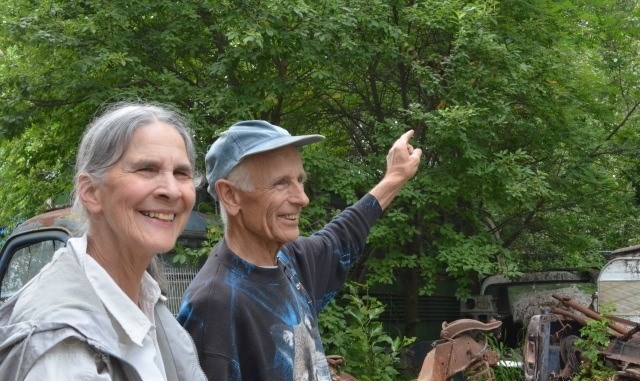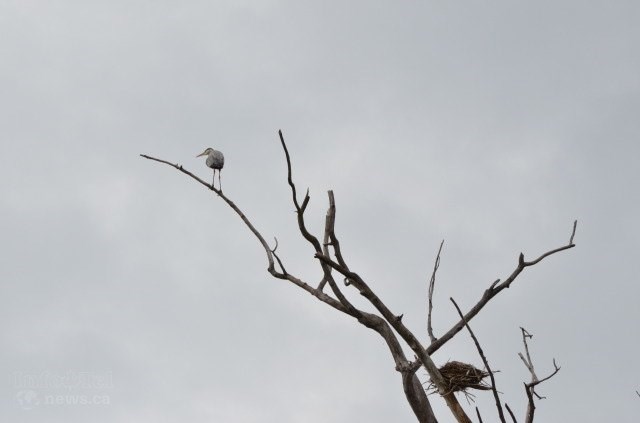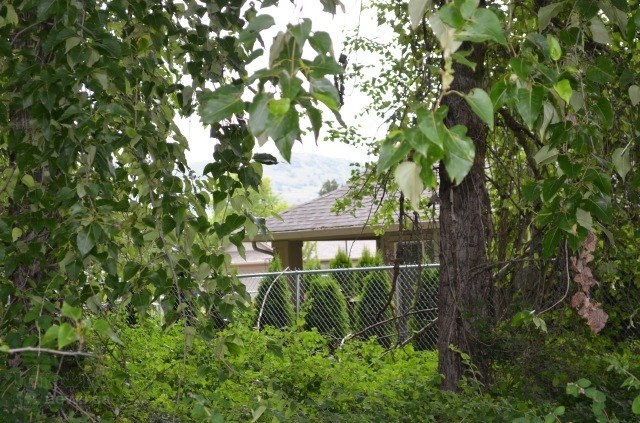
Jan and Rita Bos in their 24 Street lot where a flock of over 100 blue herons hide in the trees.
(CHARLOTTE HELSTON / iNFOnews.ca)
June 19, 2013 - 1:58 PM
"I'M APPALLED THEY GAVE THE COVENANT, THEN THEY STARTED ARGUING ABOUT WHAT IT MEANS."
A Vernon landowner is being sued after his dead tree fell onto a neighbouring home, but Jan Bos says he was legally bound not to remove it.
The 1.5 acre property on 24 Street near Walmart is home to over 100 blue herons, an at-risk species being watched closely by the Ministry of Environment. Bos, a retired elementary school teacher, says the birds started nesting in the tall Cottonwoods bordering the lot in the mid-1980s. Over the years, the colony grew to 70 nests. In 1992, Bos willingly signed an agreement with the Regional District of North Okanagan not to tamper with the habitat, including not cutting down any of the trees.
In 2003 a development went up next to the protected area, with some homes just five metres away from the property line. Now, Bos is being sued by the insurance company of one of the homes because one of the dead trees fell onto a neighbour's house in July 2010, causing structural damage to roof trusses and support beams.
"The dead trees are just as important as the live ones for perching and resting," Bos says. "You can't cut them down," Bos says.
Bos uses half the lot to store over 400 vintage and used cars—as well as a few airplanes. The herons get the other half, which Bos doesn't disturb. Over the years, Bos and his wife Rita have grown attached to the large birds, photographing them endlessly and bringing students in to observe them.
"I appreciate nature and I appreciate the birds. I enjoy sharing them with other people," Bos says. "I come here every day. Whenever the gate is open, I welcome people to come take a look."
The agreement with the district says the landowner "shall not cut trees or brush nor disturb the lands within the nesting site established by the herons in a manner that would prohibit or discourage the nesting of wild herons in their established natural habitat...."
But City of Vernon planner Dale Rintoul says the tree in question was outside the area covered by the covenant.
"We don't have any evidence with a survey plan yet, but it's our understanding it was outside," Rintoul says.
When the development was approved, Rintoul says there were restrictions placed on some of the lots, prohibiting them from building because of proximity to the heronry.
"Everywhere else was fine," Rintoul says. "At the time the house was created there were no nests or herons in the trees adjacent to the property."
He says trees falling onto the house wasn't a concern because there were no large trees around at the time. Since then, he says the Cottonwoods have grown, and those beyond the border of the sanctuary are the responsibility of the property owner.
But the statement of claim for the lawsuit says the city was warned about the risk of falling trees. It says a letter from the Ministry of Water, Land and Air Protection warned the land "did not conform to the Ministry's suggested 'buffer zones' with regard to the rookery, and that development could present a foreseeable risk."
"Please be warned that proceeding with the development as planned will place workers and residential units within the potential falling radius of some of these trees," the letter said.
Plaintiffs Harold and Blanch Rose are suing Bos, the regional district, the City of Vernon, and the developers.
It alleges Bos "ought to have known the tree constituted a hazard" and was negligent for "failing to contact the District to inform them of the health of the tree."
It accuses the regional district of failing to perform inspections of the property, and it should have known the apparent hazards of the tree. It blames the City of Vernon for "fail(ing) to enforce the recommended 'buffer zones.'" It alleges the developer was negligent in developing the Rose property "despite knowing of the foreseeable risk posed by the trees."
Bos says he was always happy to honour the covenant, and now feels betrayed because he's not getting much support from the district.
"I'm appalled they gave the covenant, then they started arguing about what it means," he says. "I insist they are the party responsible."
Patrick Nicol, regional district chair, says he can't say much about the issue because "it's before the courts."
"To (Bos') credit, he has protected that habitat for over 20 years," Nicol says. "It's an unfortunate set of circumstances."
To contact the reporter for this story, email Charlotte Helston at chelston@infotelnews.ca or call (250)309-5230. Follow on Twitter @charhelston

Herons visit the property yearly to nest and raise their young. They are currently blue listed, meaning they are an at risk species.
(CHARLOTTE HELSTON / iNFOnews.ca)

A housing development went up beside the habitat in the 1990s. Recently, one of the homes was damaged by a tree that fell from Bos' property. The owner's insurance company is suing Bos for damages.
(CHARLOTTE HELSTON / iNFOnews.ca)
News from © iNFOnews, 2013